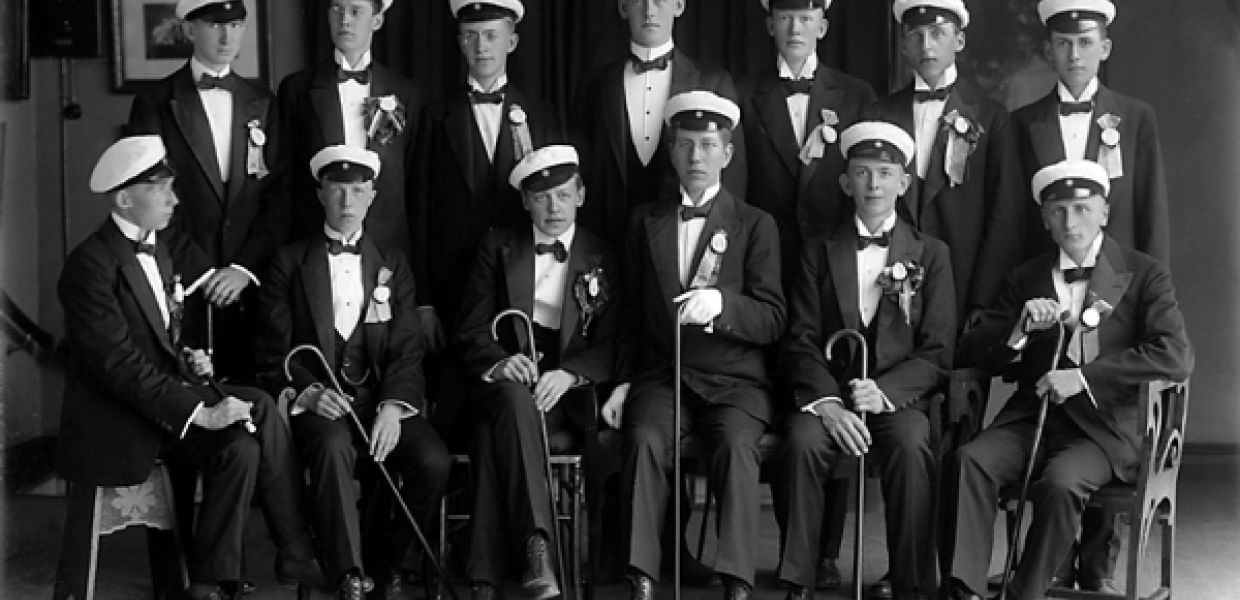The rise of the MOOC for digital cultural heritage
Our colleagues at Europeana wanted to teach people about the Europeana Data Model. How did they do it? They created a MOOC - a Massive Open Online Course.

- Title:
- Enligt tidigare notering: "Studentgrupp, 1918.".
- Creator:
- Lundbäck, Maria.
- Date:
- 1918
- Institution:
- Bohusläns museum
- Copyright:
- Public Domain
(It’s not available just yet but watch this space, we’ll let you know when it is). And they’re not the only ones getting the MOOC bug.
MOOCs have changed the student experience. Anyone who can use a computer can study pretty much anything from pretty much anywhere, usually for free. As such, MOOCs come under that buzzword heading of ‘disruptive technology’.

Being a student doesn't look like this anymore. Enligt tidigare notering: "Studentgrupp, 1918.". Lundbäck, Maria. Bohusläns museum. Public Domain.
In the last couple of years, the number of MOOCs in total, and the number of MOOCs relating to culture, has grown by quite some margin. Just three years ago, researchers speaking at a MOOCS in cultural heritage event concluded that it was ‘still early days’ and that ‘there isn’t a lot out there’ for cultural heritage. But today it’s a different story.
Coursera lists over 250 courses in the arts and humanities. US-based EdX offers 100 courses under the heading ‘Art & Culture’. Then there's FutureLearn, which has more of a UK slant with partners including the British Library, British Film Institute and British Museum, has around 40 cultural heritage courses. And iversity, based in Germany, also has some interesting courses for culture.
If your interest is not so much in the cultural heritage material itself, but working with it from a technical point of view, there are also many courses about data science, things like dealing with datasets and big data.
Who’s making MOOCs?
Not just the higher education establishments. The GLAM sector itself has got in on the game with courses run by the American Museum of Natural History, for example, or The Museum of Modern Art,
This is a global thing. The names that recur most are the big-name US universities like Yale, Stanford, Princeton and Berklee. But Europe also features prominently with courses from universities in Amsterdam, Milan, London and Leiden, Barcelona and Rome, to name just a few.
The global perspective is often reflected in a single course too. Because it’s an online, distance tool, the teachers can be anywhere. Take ‘Magic in the Middle Ages’, for example, it’s a course from the University of Barcelona, but it’s taught by academics from Harvard, Barcelona, Louvain and Madrid.
Cultural heritage content at the heart of a MOOC
The act of digitizing cultural heritage collections is of course a benefit to MOOCs as it means they have a huge range of material available to illustrate their topics. The more we can work at opening up collections by making high quality files available for this kind of educational use, the more MOOC makers will turn to cultural content as a resource.
MOOCs on the subject of Europeana
If you want to take a course about Europeana, look at Europeana Space: Creative with Digital Heritage on EdX.
There’s a Metadata Mooc that uses Europeana in its examples too. Back when the course was first released, we talked to the course director about it. Read our blog.
And we’ll let you know when you can sign up for the new MOOC about the Europeana Data Model.
